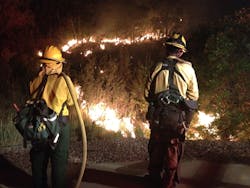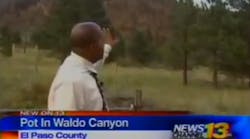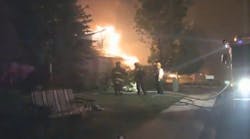Operational weaknesses revealed during the Waldo Canyon fire included poor communications between agencies, vague evacuation policies and a lack of staff disaster training, according to an initial after-action report released Tuesday by the City of Colorado Springs.
But the city's first public critique of its actions during the fire provides few specific recommendations, and when questioned during a Tuesday news conference city officials did not elaborate. A full review is expected in March.
The report focused only on the city's emergency operations.
Still, officials say the ongoing review is important for the city's disaster preparedness.
Whether or not an incident similar to the destructive fire, which claimed 346 homes and two lives, will happen again, the lessons learned could guide officials in any disater, said Bret Waters, Emergency Operations Manager for the city.
"We want to be transparent as a local government, that's why we're releasing this publicly," Waters said Tuesday. "It will help with future disasters, not necessarily wildfires."
Waters continually stressed that disasters are unexpected. The purpose of the review is to assess how the city acted under extreme expectations, and teach its officials to be prepared for the unexpected.
"In a disaster, there is never a perfectly scripted or planned out event," Waters said. "We had a lot of strengths in this event."
Overall, local officials were pleased with the collaboration between agencies in Colorado Springs during the fire. The report cited favorably the Emergency Operations Center's "demonstrated history" of running evacuation drills in the wildland urban interface, the type of hillside neighborhood heavily affected by the fire. In previous years, drills were run on a volunteer basis -- those who wanted to participate could, Waters said.
The wildfire mitigation plans launched by the city in 2001 withstood the test of flames, according to the report -- a victory highlighted by the survival of Cedar Heights, officials said.
But for every appraisal of what went well, the city balanced it with with thematic, generic points of what didn't. Several elements, such as documenting decisions and timing, as well as developing a clear staffing plan that allowed for regular shift changes, seemed to be lacking, according to the report. The city's breakdowns generally centered around communications -- whether that meant identifying a Communications Unit Leader, talking to other agencies or directing fire crews to the right spot during the fire.
Other areas singled out for improvement included documentation of events, logistics training and incident management training for a relatively unprepared staff, as well as improving Emegency Notification System that sent out evacuation announcements. The El Paso-Teller E911 Authority commissioned an independent report examining that system, which is due in November.
Fire Chief Rich Brown said his employees painstakingly put together a time-line of the June 26 firestorm, relying heavily on radio records and in-person recollections. But, they did not have a written, time-stamped record of command decisions; unless a decision was broadcast on the radio it was not time-stamped, he said. Part of the city's plan to improve documentation includes training scribes and record-keepers.
"There's got to be a better way," Brown said. "Scribing or codifying orders given is important because people want to know we're doing things appropriately. Unequivocally, yes, we were," he added, but it's wise to keep a record.
The consequences of the city's actions were not only felt by those in the emergency operations center, but also by those who came to assist.
Wildland firefighters from Pueblo West were summoned by a mutual aid call as the fire blew into Colorado Springs just after 4 p.m. on June 26. The Pueblo crew sent one engine, loaded with as many firefighters as it could hold, to Colorado Springs. It was among 39 agencies from across the state that responded to the mutual aid call, the after-action report shows.
The Pueblo West team's arrival was a surprise to fire crews in Colorado Springs, said Division Chief Brad Davidson. The Pueblo firefighters didn't have the appropriate channels on their radios, and were not able to immediately get the radios necessary for them to get into the firefight. They waited while officials figured out what to with them, Davidson said. The report attributed the problem to the absence of an organizational chart.
"Coordination of arriving resources through an established staging area with the on-scene IC was often ineffective or non-existent, which prevented accurate accountability of all crews/personnel operating in the area that was immediately dangerous to life and health," the report reads.
But the nature of disaster is chaos, and at one point fire Capt. Steve Riker told Brown that he had more people clamoring to fight the fire then he knew how to use.
"The logistics piece at times can be overwhelming," Brown said. "At times you can't get them into the fight. We weren't beefed up to handle that many folks."
Ultimately, firefighters saved 82 percent of all the homes in the burn area, despite the odds -- as the report says, when faced with "a historic incident of epic proportions."
McClatchy-Tribune News Service








